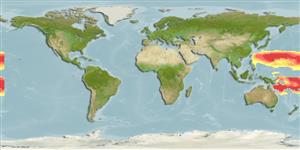Klassifizierung / Names
Common names from other countries
Hauptreferenz
Size / Gewicht / Alter
Max length : 15.8 cm SL Männchen/unbestimmt; (Ref. 11333); 9.7 cm SL (female)
Lebensraum
; seewasser bathypelagisch; tiefenbereich 0 - 415 m (Ref. 11333)
Klimazone / Range
Deep-water, preferred ?
Verbreitung
Kurzbeschreibung
A single, ovoid terminal bulb 1-1.2% SL. Barbel length short to intermediate 32-60% SL. Short terminal filaments 9 or more of various sizes; shortest filaments often bulblet-tipped; longer ones with bulblets and inclusions of various sizes and shapes; 1 filament thicker and longer than others, not forked, with 1 or more long inclusions filling most of its distal end. Axis of stem lightly or not pigmented. A dark spot usually at the base of the bulb. External chevron-shaped or roundish striated areas unpigmented. Middorsal paired spots between occiput and dorsal-fin origin 7 (Ref. 11333).
IUCN Rote Liste Status (Ref. 115185)
Bedrohung für Menschen
Harmless
Nutzung durch Menschen
Mehr Information
NamenSynonymeMetabolismusRäuberÖkotoxikologieFortpflanzungGeschlechtsreifeAblaichenFecundityEierEientwicklung
Alter/GrößeWachstumLänge-GewichtLänge-LängeLängenhäufigkeitenMorphometrieMorphologieLarvenLarven Pop.Dyn.RekrutierungDichte
ReferenzenAquakulturAquakultur ProfilZuchtlinienGenetikAllel-HäufigkeitenVererbbarkeitKrankheitenVerarbeitungMass conversion
PartnerBilderStamps, CoinsLauteCiguateraGeschwindigkeitSchwimmstilKiemenoberflächeOtolithsGehirngrößeSehfähigkeit
Tools
Zusatzinformationen
Download XML
Internet Quellen
Estimates of some properties based on models
Phylogenetic diversity index
PD50 = 0.5000 many relatives (e.g. carps) 0.5 - 2.0 few relatives (e.g. lungfishes)
Trophic Level
4.3 ±0.8 se; Based on size and trophs of closest relatives
Widerstandsfähigkeit
mittel, Verdopplung der Population dauert 1,4 - 4,4 Jahre. (Assuming tmax>3)
Verwundbarkeit
Low to moderate vulnerability (26 of 100)
Preiskategorie
